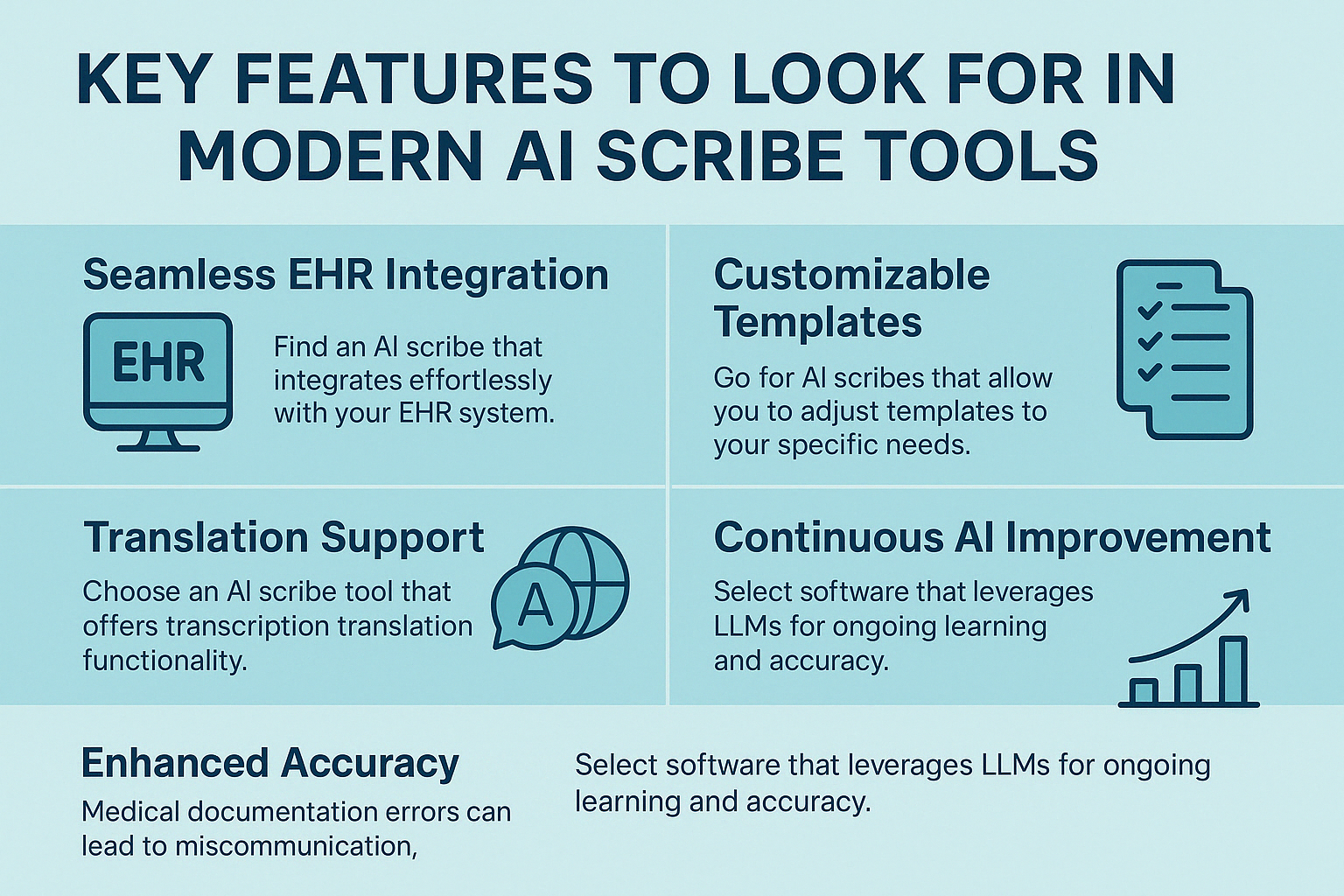Why Healthcare Providers Are Turning to AI Scribes

Believe it or not, the scribe profession dates back thousands of years, nearly as far as the invention of writing itself. Historians note that scribes in ancient Egypt and Mesopotamia were highly educated individuals responsible for recording events and managing administrative duties. These scribes often belonged to the upper tiers of society, sometimes even the nobility. Even today, the role of the scribe remains valuable in select fields, particularly in healthcare.
The Role of Medical Scribes
The term medical scribe is fairly self-explanatory. These professionals assist clinicians by documenting patient consultations in real time. Traditionally, this meant physically shadowing doctors and taking notes during visits. Over time, the process evolved from handwriting on paper to entering data into electronic devices.
With rapid advances in technology, we have now reached an era where many scribes work remotely. Known as virtual scribes, they carry out their responsibilities from across the globe. However, even this model is beginning to shift. The next major step in this evolution is the rise of AI scribes.
An Introduction to AI Scribes
AI scribes are software tools designed to automate the clinical documentation process. These systems use speech recognition and advanced large language models to transcribe conversations between doctors and patients. They generate clinical notes in real time by listening through a microphone during consultations.
For those wondering whether AI scribes are truly effective in healthcare settings, the answer is a strong yes. Their accuracy and streamlined performance are among the key reasons clinicians and healthcare providers have begun relying on them. Unlike basic voice-to-text apps, AI scribes can filter out non-essential dialogue and deliver clear, structured notes.
The potential does not stop there. Developers are actively working on adding new capabilities that go beyond transcription. In the near future, AI scribes may assist with referrals, support clinical decisions, and contribute even more to daily medical operations.
Why AI Scribes Are a Game Changer for Healthcare
In recent years, artificial intelligence has rapidly transformed nearly every major industry, and healthcare is no exception. This surge in innovation has led to the rise of AI-powered medical scribe solutions designed to support clinicians in their daily workflows.
Below, we outline some of the key benefits of adopting AI scribes in clinical settings to help healthcare providers make informed decisions about integrating this technology.
- Reduces the Risk of Physician Burnout
Managing electronic health records every day can lead to significant stress and fatigue for clinicians. In fact, one study found that physicians spend an average of 16 minutes per patient just on EHR-related tasks. This ongoing administrative burden contributes heavily to burnout. AI scribes help alleviate this issue by automating the documentation process. Some healthcare professionals report cutting their note-taking time by as much as 50 percent, allowing them to focus more on patient care and less on clerical work.
- Improves Administrative Workflow
Administrative tasks like clinical documentation and managing EHR entries can slow down day-to-day operations and reduce overall efficiency. Many clinicians report difficulty in locating relevant patient information despite navigating through multiple screens, which disrupts their productivity. AI scribes address this challenge by automating the documentation process and streamlining data access. Some advanced AI solutions are also beginning to offer added support, such as generating referrals, care plans, and prescription summaries, helping clinicians work more efficiently and stay focused on patient care.
- Heightens the Quality of Care
AI scribes automate EHR documentation, giving physicians more time to focus on patient interaction rather than searching for records or entering data. This shift allows for more attentive and personalized care during each visit. By reducing administrative distractions, AI scribes help improve the overall patient experience, often resulting in higher satisfaction and better long-term outcomes.
- Cost-Effective Solution
AI scribes are an affordable alternative to hiring full-time human scribes or overburdening physicians with documentation tasks. With flexible monthly or annual subscription plans, AI scribe tools offer a predictable and often lower-cost option. When compared to the cumulative cost of clinician overtime or administrative staffing, AI scribes deliver strong value without compromising on efficiency or accuracy.
- Better Data Compliance
Compliance is critical in healthcare, and leading AI scribe tools are built with strict data security in mind. Most solutions are designed to meet regulatory standards like HIPAA, ensuring that patient information is handled responsibly and securely. These tools do not store patient data but instead transcribe encounters in real time, generating ready-to-bill notes while protecting sensitive information throughout the process.
Key Features To Look For in Modern AI Scribe Tools

AI scribes are a groundbreaking innovation, helping reduce the administrative load in healthcare. However, not every solution offers the same value. To ensure you’re selecting the right tool for your practice, here are a few essential features to look for:
- Seamless EHR Integration
An AI scribe is only as valuable as its ability to work with your existing systems. That’s why it’s essential to choose a solution that integrates effortlessly with your current Electronic Health Record setup. Seamless integration allows for smooth data transfer, reduces the need for manual entry, and helps streamline clinical workflows. The result is less time spent on paperwork and more time focused on patient care.
- Customizable Templates
Every medical practice has its own unique workflow, which makes flexibility essential. That’s why it’s important to choose AI scribes that offer customizable templates. This feature allows clinicians to tailor documentation formats to fit their specific needs, helping maintain consistency across patient records. Some advanced AI scribes can even convert audio recordings directly into complete medical forms, adding another layer of convenience and efficiency.
- Translation Support
In today’s diverse healthcare landscape, language barriers can present real challenges. Some of the most advanced AI scribes offer built-in translation features that convert conversations into multiple languages. These tools are designed to understand a wide range of dialects and accents, making it easier for clinicians to provide clear and accurate care across different patient populations. This added layer of support enhances communication and ensures nothing important is lost in translation.
- Continuous AI Improvement
A valuable AI tool should evolve alongside advancements in healthcare and technology. The best AI scribe software is built on Large Language Models that continuously learn, adapt, and improve with time. This ongoing development leads to better accuracy and efficiency. As the technology matures, it has the potential to significantly reduce documentation errors and lower claim denial rates, offering long-term value to both clinicians and healthcare systems.
What to Expect from Medical AI Scribes
Medical AI scribes have already brought significant convenience to healthcare professionals, and their capabilities are expected to grow rapidly in the coming years. Beyond automating clinical note-taking, future AI scribes are likely to assist with treatment plan suggestions, follow-up reminders, and other clinical decision support features.
For broader adoption, however, these tools will need deeper integration with Electronic Health Record systems. Seamless integration will allow AI scribes to deliver tailored recommendations based on patient history and real-time data. While only a few solutions currently offer these advanced capabilities, ongoing improvements are addressing key concerns around data privacy and patient confidentiality.
Moving forward, we can expect AI scribes to incorporate stronger security measures, clearer transparency, and enhanced ability to manage sensitive patient information responsibly. Their growing accuracy and reliability make them a promising tool for the future of healthcare.
As adoption increases, there will be a stronger push for regulatory frameworks to ensure AI scribes remain both effective and compliant. This progress will not only improve documentation workflows but also enhance the overall patient experience across the healthcare ecosystem.
Key Takeaway
Are AI scribes truly valuable in healthcare today? The answer is yes. Even in these early stages, AI scribe tools have shown strong potential. They significantly reduce the documentation workload, save time, and allow healthcare providers to focus more on patient care. That alone marks them as a major step forward in clinical efficiency.
In recent years, many clinicians have reported positive experiences with AI scribes. Some even describe the technology as transformational, improving both patient outcomes and their own daily workflows.
The burden of clinical documentation has become a major challenge in healthcare. It affects physician well-being, patient satisfaction, and overall quality of care. AI scribes have stepped in as a timely solution, reducing that burden and supporting physicians in delivering better care. As electronic health records grow more complex, these tools provide a much-needed assist, simplifying the process and strengthening the entire healthcare system.
About the Author
Nathan Murray, M.D. Emergency Medicine - Founder of DocAssistant
Dr. Nathan Murray is an Emergency Medicine trained physician and the founder of DocAssistant. With years of frontline clinical experience, Dr. Murray is passionate about using AI to streamline medical documentation and enhance clinical decision making.



